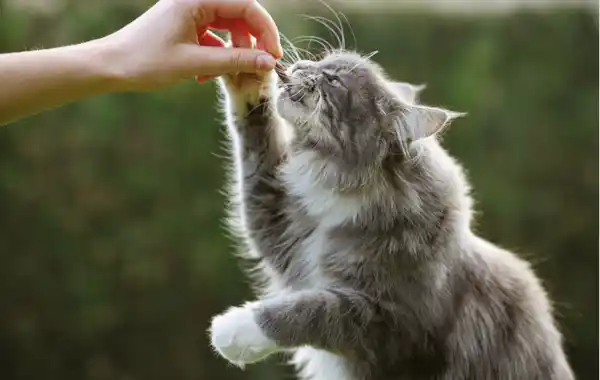Follow these easy training tips and you'll soon have a cat that comes to you when you call him!
Finding the 'super power' rewards
The first step is to ensure you have some really exciting rewards. This is vital if you are going to use your recall outdoors as many cats find being outside really exciting. You need to have a selection of rewards that are even more exciting so that your cat deems it worthwhile to come back. We want to use those ‘super power’ rewards. Find out what treats your cat loves most and what games he likes best.
Content continues after advertisements
Begin to train
- First, choose the word you will use as the command to come to you. It’s best to avoid using only your cat’s name, as he may not understand that you want him to approach you. Thus, calling the name is just used to get the cat’s attention and then a new special word becomes the command to come to us.
- At first, your cat will not know what this new word suddenly being directed at him means, so you’ll need to teach him. Start your training at a time when your cat is keen to interact. Place yourself at the cat’s level and call his name to get his attention. Then use your chosen command. Follow this immediately by what you normally do to get your cat to come to you. Some owners rub their fingers together, for example. As soon as your cat reaches you, reward with your chosen treat.
- If your cat does not normally come to you easily, try luring him using a treat or a game. Say his name followed by your command and then show your cat the food you have — let him sniff it but do not let him eat it until he is beside you. If you wish to use a game, entice your cat to come to you by moving the toy and play with him once he approaches you.
- For a cat that is nervous of approaching, build this stage up by placing several treats in a path towards you after saying your cat’s name and command. Gradually, you will be able to remove the lure.
- Once this is working reliably and your cat is coming to you on hearing his name and command, start to increase the distance between you, eventually from different rooms in the house. Having rewarded your cat for coming to you, give him the opportunity to leave again if he wishes. You don’t want him to think coming to you means restraint but instead leads to something tasty or fun.
Training your cat outdoors
If your cat has outdoor access and you are at the stage where your cat will come to you from different locations in your house, it is time to start trying it outdoors.
- Start in your garden while your cat is still close to the house. You started your training in the home at a very close distance to your cat and when he was hungry, feeling affectionate or playful, so do the same outside. Try it in many locations in the garden, luring your cat in different directions.
- Use your ‘super power’ rewards now you are outdoors. When your cat comes to you, reward and praise, then let him explore again. It is really important to recall your cat at times when you do not actually need him to come indoors so that he does not learn that coming to you always ends in being brought inside, which could cause the power of your recall to diminish.
- Initially, you may just reward your cat for coming to the door, but build this up to rewarding him for coming into the house and give him his reward inside. This way, you prevent creating the situation where the cat will come to you but not come inside.
- Once the recall is fully established, you do not need to reward the recall with a treat every single time your cat comes. This will keep him interested in the task as he’ll never quite know which recall will bring the treat. However, only go to this stage once you can reliably get your cat to come whenever you call him. If at any stage he stops coming when you call, go back to the initial training stages.







